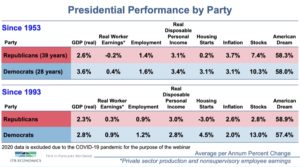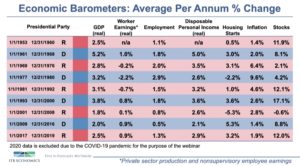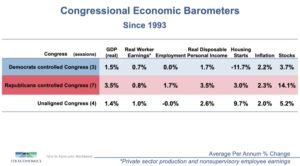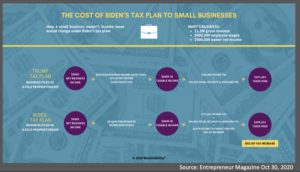(Editor’s note: The results of the 2020 Presidential Election have yet to be certified in several states. At press time, a manual recount of votes in a few key states is under way. To that end, ITR Economics is forecasting what “might happen” under a Biden administration; the company stressed the fact it is not calling a winner in the race. “We are going to do our level best to be apolitical about this,” said Brian Beaulieu, chief economist and CEO of ITR Economics. “For us, it’s all about the numbers. It’s not about one party vs another party.”)
By Reginald Tucker
 “If you have been holding back on expectations for the next four years, that probably isn’t a good approach,” Beaulieu said. “It’s reasonable to expect to see some growth over the next four years.”
“If you have been holding back on expectations for the next four years, that probably isn’t a good approach,” Beaulieu said. “It’s reasonable to expect to see some growth over the next four years.”
That was the gist of a recent virtual keynote presentation from renown economic forecaster ITR Economics. During a recent webinar, titled “The Results Are In: This Is What Changed for 2021-2022,” twin brothers Brian (CEO and chief economist) and Alan Beaulieu (president) provided their insights and in-depth analysis based on both historical and forward-looking data to discern how some of President-Elect Joe Biden’s signature policies stand to impact the U.S. economy.
On the whole, ITR Economics said growth will continue into the new presidency—barring a large-scale shutdown by governors at the local/state levels. They said Biden will: encourage the continuation of reshoring/onshoring jobs back to America; maintain a firm stance with China on trade; and focus more attention on infrastructure improvements and green energy technologies.
However, Alan and Brian did express some concern over Biden’s plans to raise taxes. Such a move, they said, could discourage business owners from hiring and/or reinvesting in their businesses. The experts also said raising taxes will do little to shore up Social Security funding.
All in all, though, ITR forecasts growth will likely continue over the next four years. From a historical perspective, they predict the housing market will remain strong—as it has under previous Democratic presidents. They also feel an unaligned Congress will actually bode well for the economy—again, based on historical performance.
Following are some highlights from the presentation:
Handling of the COVID-19 crisis
Amid the delay in the transfer of power as the Trump administration disputes the election results, states across the country are seeing rises in both positive cases and hospitalizations. How the U.S. government deals with the latest surge will likely have more of an impact on the continued U.S. economic recovery than any one policy shift from the new administration.
“Our assumption regarding COVID-19 continues to be this: governors, despite their loose language, are not going to uniformly shut down their economy like they did back in March or April,” Brian said. “It is true that the death count is rising in the United States, but the fatality rate is so low that the governors don’t have to resort to that draconian lockdown method again.”
ITR is also optimistic about the medium-to-long-term prospects of the track of the novel coronavirus. “That’s assuming that a viable vaccine is identified by the second quarter and that the logistics of distributing a vaccine will be overcome,” Brian added. “Furthermore, that the vaccine becomes more widely available to the general population as we go through 2022.”
Alan agreed, adding, “If that vaccine becomes more widely available sooner, that’s just going to improve the slope of what we’re talking about.”
The Déjà vu factor
In a previous ITR webinar presentation, “Economic Guidance in an Uncertain Economy,” the company cited historical data showing a direct correlation between a stronger stock market under Republican leadership, but a healthier housing market under Democrats. In its latest webinar, ITR Economics—citing deeper statistical research dating back to 1953—doubled down on that assertion.


 “GDP growth over that period is counter to what we thought we were going to see—we thought it would be much more even,” Alan said, citing the newly gleaned data (see “Presidential Performance by Party” and “Economic Barometer” charts). “Indeed, since 1993, 2.3% GDP growth vs 2.8% is fairly close, but you still have to give the nod to the Democrats, statistically speaking, during that period. If I was a home builder, I may be a little bit more optimistic about the next four years.”
“GDP growth over that period is counter to what we thought we were going to see—we thought it would be much more even,” Alan said, citing the newly gleaned data (see “Presidential Performance by Party” and “Economic Barometer” charts). “Indeed, since 1993, 2.3% GDP growth vs 2.8% is fairly close, but you still have to give the nod to the Democrats, statistically speaking, during that period. If I was a home builder, I may be a little bit more optimistic about the next four years.”
Statistically speaking, democratic presidents also seem to do better in the category of worker earnings, ITR research showed (see chart). “The takeaway from this, objectively is, if it is President Biden in January, that means better days ahead over the course of the next four years,” Brian said.
However, “presidential performance by party” stats are much more even when looking at the “American Dream” factor—that is, the percentage of U.S. citizens who own a home. “Whether from 1953 to the president who was in power in 1993 all the way to the present, there has been a virtual dead heat between the two parties,” Alan explained.
What about the role Congress plays? In the 2020 election, Americans not only cast their votes for president, but also for their congressmen and representatives. As of press time, Republicans appear to have narrowly retained their lead with respect to Senate seats. What impact will this have on a new administration? Dating back to 1993, metrics such as GDP, real worker earnings and stocks, to name a few, all appear to fare better under a Republican-controlled Congress, according to ITR Economics research (see “Congressional Economic Barometers” chart).
Potential impact of changes in tax policy
Part of President-Elect Biden’s plan is to impose an additional 12.4% payroll tax on earned income above $400,000. Pundits are framing it as a step toward staving off the elimination of Social Security, but ITR said the numbers just don’t work. “It doesn’t eliminate the shortfall, it just delays it by two or three years,” Alan estimates.
 The larger issue according to ITR, is the potential impact of tax cuts on corporate profitability as well as the ability of small businesses to reinvest their profits (see “Cost of Biden tax plan” chart). On one hand, ITR noted, the 2017 cut in the top tax rate did not translate into a “big surge in 2018 corporate profitability,” Alan said. “This indicates to us that corporate profitability is dependent upon much more than taxes.”
The larger issue according to ITR, is the potential impact of tax cuts on corporate profitability as well as the ability of small businesses to reinvest their profits (see “Cost of Biden tax plan” chart). On one hand, ITR noted, the 2017 cut in the top tax rate did not translate into a “big surge in 2018 corporate profitability,” Alan said. “This indicates to us that corporate profitability is dependent upon much more than taxes.”
On the downside, a higher tax burden on small businesses clearly limits the ability of those small companies to hire, train and expand. Furthermore, the absence of qualified income incentives and/or tax credits for small businesses raises additional concerns, according to ITR.
“That’s money that could be put to work to automate businesses or hire more people,” Alan said. “Higher taxes could mean limits on a company’s ability to grow or provide decent raises for employees. That concept is lost on a lot of people.”
Still, ITR said it’s not a deal breaker. “At the end of the day, there are things business owners can do to make money despite what’s going on,” Brian said. “Overcoming obstacles is what small businesses do. Don’t set a strategy or tactics based on the tax rate.”
(Look for more on this story in the Nov. 23/30 issue of FCNews.)
